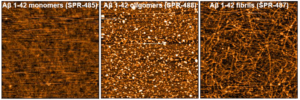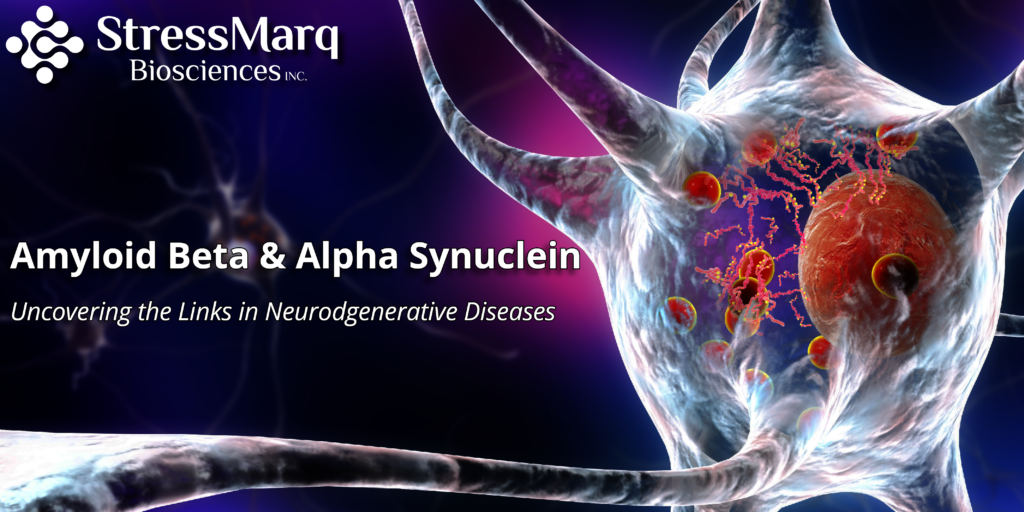Uncovering Links Between Amyloid Beta and Alpha Synuclein in Neurodegenerative Diseases
Alzheimer’s disease (AD) and Parkinson’s disease (PD) are the two most common neurodegenerative disorders, respectively characterized by cerebral accumulation of Amyloid Beta (aka β-amyloid or Aβ) and Alpha Synuclein (aka α-synuclein or αS). Both Aβ and αS aggregate via similar pathways, starting out as monomers before assembling into toxic oligomeric species and insoluble fibrils. However, while the Aβ aggregation pathway was originally thought to be associated only with AD, and the αS aggregation pathway linked only to PD, the fact that many patients exhibit clinical and pathological features of both diseases suggests there to be some overlap. A growing body of evidence supports the existence of a synergistic relationship between Aβ and αS, spanning the discovery of an αS protein fragment in the amyloid plaques of AD patients almost thirty years ago to more comprehensive interrogation of Aβ-αS interactions today.
Evidence suggests a synergistic relationship between Aβ and αS
A connection between AD and PD first began emerging in 1993, when a peptide referred to as the non-Aβ component (NAC) was discovered in amyloid plaques isolated from AD brains1. This was subsequently found to be a fragment of αS, corresponding to residues 61–95, leading researchers to hypothesize that AD and PD might have overlapping pathologies. Evidence to support this theory has since amassed, including the significant histological observations that many AD patients exhibit αS Lewy bodies (the characteristic hallmarks of PD), while those diagnosed with PD with dementia (PDD) often have Aβ plaques2.
Other studies using patient brain tissues have focused on uncovering the relationship between Aβ accumulation and the phosphorylation of αS at serine-129, which represents the predominant modification of αS in Lewy body diseases including PD, PDD, and dementia with Lewy bodies (DLB). ELISA-based measurement of Aβ40 and Aβ42 (the two major Aβ isoforms), and both αS and pSer129 αS, in brain homogenates has shown levels of Aβ, especially Aβ42, to correlate with αS phosphorylation at Ser129, a finding that is replicated when SH-SY5Y cells are exposed to aggregated Aβ42 in vitro3.
Transgenic animals have also been fundamental to advancing researchers’ understanding of the synergies between Aβ and αS. For example, mice featuring neuronal expression of both human Aβ and αS have been found to present motor deficits earlier and have more severely impaired learning and memory compared to αS singly transgenic mice, as well as exhibiting more αS-immunoreactive neuronal inclusions4. Importantly, the authors of this particular study also showed Aβ peptides promote αS aggregation in a cell-free system and cause intraneuronal αS accumulation in cell culture, indicating that drugs developed to block the production or accumulation of Aβ peptides might be used to treat a broader spectrum of neurodegenerative disorders than once thought.
High-quality tools for studying the relationship between Aβ and αS
Our product portfolio encompasses a wide selection of tools for determining how β-amyloid and α-synuclein function together in neurodegenerative disorders such as AD and PD. Our β-amyloid products include Aβ monomers (catalog# SPR-485), Aβ oligomers (catalog# SPR-488), and Aβ pre-formed fibrils (catalog# SPR-487), and are complemented by a range of antibodies that includes our Anti-Amyloid Oligomers (A11) Antibody (catalog# SPC-506) and Anti-Amyloid Fibrils (OC) Antibody (catalog# SPC-507). Our Aβ oligomers and Aβ pre-formed fibrils both show a dose-dependent toxicity to primary rat cortical neurons, whereas our Aβ monomers do not.
Additionally, we offer various α-synuclein products to support researchers, including our pSer129-specific monoclonal Anti-Alpha Synuclein Antibody (catalog# SMC-600), our Kinetically Stable Alpha Synuclein Oligomers (catalog# SPR-484), and our Human Alpha Synuclein Pre-formed Fibrils (catalog# SPR-322).

AFM of amyloid beta 1-42 monomers (SPR-485, left), oligomers (SPR-488, middle) and fibrils (SPR-487, right). Atomic force microscopy analysis of 1.0 mg/mL samples diluted to 0.1 mg/mL in dH2O, mounted on freshly cleaved mica, washed, dried and analyzed with tapping mode. Representative images are 2.5 x 2.5 µm x-y with a z-range of 10 nm.
References
- Molecular cloning of cDNA encoding an unrecognized component of amyloid in Alzheimer disease, Uéda K et al, Proc Natl Acad Sci U S A. 1993;90(23):11282-11286
- α-synuclein-assisted oligomerization of β-amyloid (1–42), Chau E and Kim JR, Arch Biochem Biophys. 2022;717:109120
- Evaluating the relationship between amyloid-β and α-synuclein phosphorylated at Ser129 in dementia with Lewy bodies and Parkinson’s disease, Swirski M et al, Alzheimers Res Ther. 2014;6(5-8):77
- β-Amyloid peptides enhance α-synuclein accumulation and neuronal deficits in a transgenic mouse model linking Alzheimer’s disease and Parkinson’s disease, Masliah E et al, Proc Natl Acad Sci U S A. 2001;98(21):12245-12250


Leave a Reply